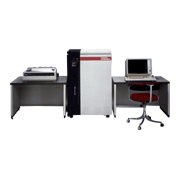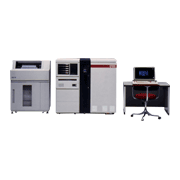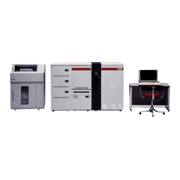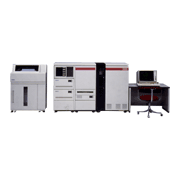This was a 2nd generation series of small computers from Fujitsu. Previously, the FACOM V Series was comprised of 3 models -- the FACOM V, V0III and V0SIII-- but this series was replaced by the New FACOM V Series comprised of four new models: the FACOM V-830 STREAM, FACOM V-830, FACOM V-850 and FACOM V-870 announced from April 1979 to July 1982.
In April 1979, the first model comprising the New FACOM V Series (the FACOM V-830) was announced as a lower model of FACOM V. At the time, there had been a remarkable development in small computers, and they were being used in an ever more diverse range of applications. Therefore, there was a strong need not only for high-performance and low price, but also for features like diverse functionality and ease of operation and installation. The same was true for office computers (small business computers used in offices). The market had expanded, and competition had heated up. On the other hand, with the advent of high-density LSI, such as microprocessors and memory elements, it became possible to reduce the size, increase the performance and lower the price of hardware. At this point, Fujitsu developed the FSSP (Fujitsu Small System Processor) -- a 16-bit LSI processor which could be used in both small computers and office computers. This processor had the following features:
(1) Higher performance and lower power consumption (about 130mW while operating) were achieved using 10,000 gate/chip CMOS LSI.
(2) The processor employed an architecture which was uniform for the FACOM V Series and well suited to interactive processing
-A 16 megabyte memory address space with leeway for expanding memory in the future
-It had four multiple execution levels, and dedicated working registers for each level, so there was no need to clear and restore registers when the execution level changed.
(3) It had a comprehensive RAS design, with parity check and diagnosis capabilities provided for computing elements, internal registers and buses.
The FACOM V-830 employed the FSSP LSI processor above, and special-purpose LSI with 3,000〜6,000 gates was also developed for channel control and control of peripheral devices. For main memory, it used highly-integrated memory such as 16 Kbit RAM and 64Kbit RAM, and thereby improved performance, reduced size, lowered cost and reduced power consumption.
Fujitsu later added the FACOM V-850 (announced in June 1980) and V-870 (announced in July 1982) as higher-end machines following the FACOM V-830, as well as a lower end model called the FACOM V-830 STREAM. Thus they created the New FACOM V Series -- comprised of the FACOM V-830STREAM, V-830, V-850 and V-870 -- which replaced the FACOM V Series comprised of the previous FACOM V, V0III and V0SIII.
| Model name: | FACOM V-830 STREAM |
FACOM V-830 |
FACOM V-850 |
FACOM V-870 |
|
|---|---|---|---|---|---|
| Announcement name |
July 1982 | April 1979 | June 1980 | July 1982 | |
| Central processing unit |
FSSP 10,000gate CMOS LSI processor | Distributed function processor system based on an SPU (System Processing Unit, 10,000gate CMOS LSI, FSSP) and IPU (Instruction Processing Unit, 700gate Bipolar LSI) | |||
| Main memory unit | Memory element | 64Kbit MOS-LSI | 16Kbit/64Kbit MOS-LSI | 64Kbit MOS-LSI | |
| Cycle time | 400ns/2B | 335ns/2B | |||
| Memory capacity | 1.25-2MB | 256/384/512KB | Max. 1280KB | 2-4MB | |
| Error check system | 1bit error correction using ECC, complete 2bit error detection | ||||
| Built-in fixed head disk unit | Size, Capacity /drive |
8inch 67/106/159MB |
14inch 40/106MB |
14inch 106MB |
8inch 40/67/300MB |
| Capacity | 134-770MB | 40/106-464MB | Max. 780MB | 474MB-3.77GB | |
| Built-in floppy disk | Single-sided 243KB/Double-sided 1.2MB/drive | Single-sided 243KB/Double-sided 1.2MB, Max. 2 drives | |||
| Max. number of connected workstations | 16 | 32 | 64 | ||
| Number of lines | Max. 16 | Max. 32 | |||
| Other | Employed 8inch disk Cartridge for data retention and magnetic tape unit (20MB) were standard equipment |
Employed high-capacity hard disk (V-830/850 15inch, V-870 8inch) Enabled connection with a wide range of workstations, and long-distance connection over 1.5Km Equipped with automatic operation functions (automatic power ON/OFF, calendar/clock, remote alarm control) Comprehensive RAS design |
|||
(Note) The above specifications are from the time of announcement, and may have been changed due to later improvement.





